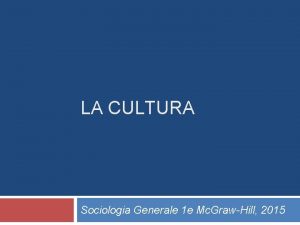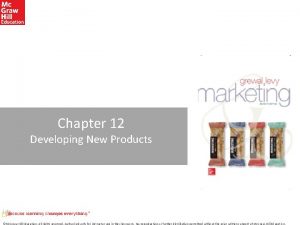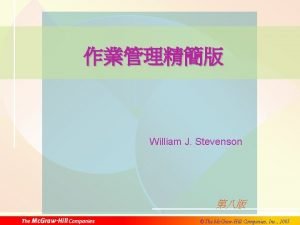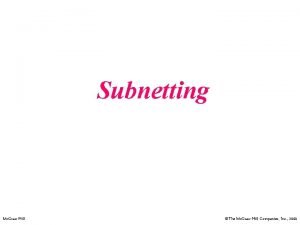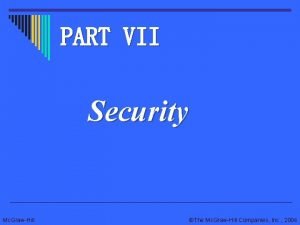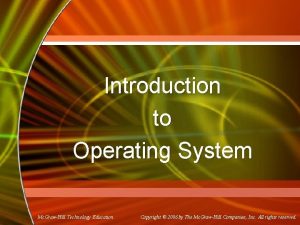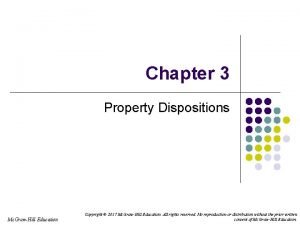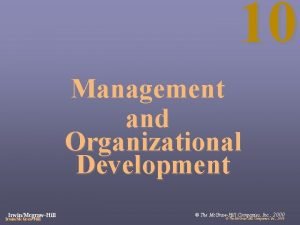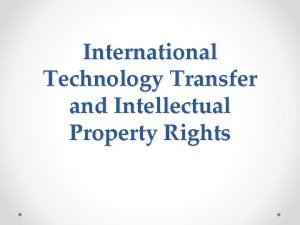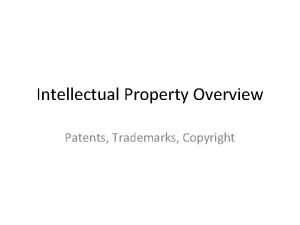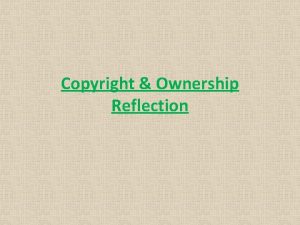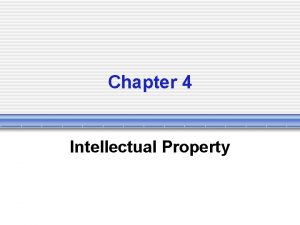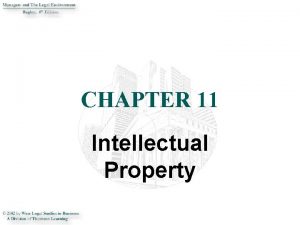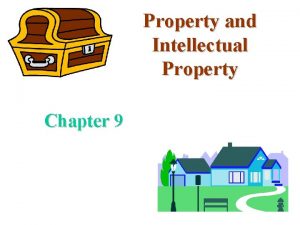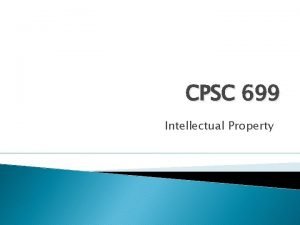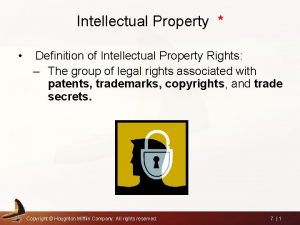Chapter 12 Intellectual Property Copyright 2015 Mc GrawHill












- Slides: 12

Chapter 12 Intellectual Property Copyright © 2015 Mc. Graw-Hill Education. All rights reserved. No reproduction or distribution without the prior written consent of Mc. Graw-Hill Education.

Chapter 12 Case Hypothetical and Ethical Dilemma As this chapter indicates, one source of controversy for copyrighted works is the application of the “fair-use” doctrine. This doctrine provides that others may reproduce a portion of a copyrighted work for purposes of “criticism, comment, news reporting, teaching (including multiple copies for classroom use), scholarship, and research. ” In determining whether the fair-use doctrine provides a valid defense to a claim of copyright infringement, Section 107 of the Copyright Act requires that a court weigh the following four (4) factors: (1) The purpose and character of the use, including whether such use is of a commercial nature or is for nonprofit educational purposes; (2) The nature of the copyrighted work; (3) The amount and substantiality of the portion used in relation to the copyrighted work as a whole; and (4) The effect of the use on the potential market for or value of the copyrighted work. Suppose that without receiving permission from the publisher for the courserequired textbook, your college math professor copies the “chapter-end” problems for each chapter covered in the course and distributes them to students, requiring students to write their answers on the copies and return them as graded assignments. Students receive the copies without charge. Is this a copyright violation, or is it “fair use” (Be sure to apply the “four-factor” test set forth in Section 107 of the Copyright Act to assist you in determining whethere is a copyright violation in this case)? 12 -2

Chapter 12 Case Hypothetical Davidson’s Microbrew, Inc. is a small beer manufacturer located in Denver, Colorado. The owner of Davidson’s Microbrew, Benjamin Davidson, takes great pride in offering the public a variety of beers, including a particular one that is currently the subject of litigation. “Barley. Davidson” is a dark brew closely resembling motor oil in its appearance. For the past three (3) years, Barley-Davidson has been sold in orange cans. There is a “bar-and-shield” logo on the can’s front closely resembling the iconic Harley-Davidson logo; in the “bar” portion of the logo, the “Barley-Davidson” name appears, and the words “Asphalt-Dark Beer” appear in the “shield” portion of the logo. On the back of the can, in small but legible print, the following disclaimer appears: “Not affiliated with Harley-Davidson Motor Company. ” Barley-Davidson has become Davidson’s Microbrew’s most popular product, selling approximately 250, 000 units per year. In its lawsuit against Davidson’s Microbrew, Harley-Davidson has requested an injunction (temporary, pending litigation, and permanent, post-litigation) and money damages based on all profits generated by the defendant in its sale of Barley-Davidson’s Microbrew’s defense is based on four (4) contentions: first, its product (beer) is distinguishable from Harley-Davidson’s product (motorcycles); second, its product disclaimer (indicating its nonaffiliation with Harley-Davidson Motor Company) is displayed on every can of Barley-Davidson it sells; third, the “Barley” portion of its dark beer’s name has nothing to do with Harley. Davidson; and four, the “Davidson” portion of the beer’s name is proudly associated with the name of the microbrew’s company, and the last name of the microbrew’s founder himself. What is the likely result of the litigation? 12 -3

Chapter 12 Case Hypothetical Bernie Sides is a restaurant entrepreneur and an avid Civil War buff. Over the years, Bernie has collected a “treasure trove” of Civil War memorabilia, and he decides to combine his passions for restaurant ownership and Civil War history by opening a new restaurant called the “Hardtack Café” (“hardtack” is a hard, unsalted biscuit used as a staple for Civil War army rations. ) Sides has devised a logo for the restaurant, and the logo (a yellow circle with red lettering for the name of the restaurant) bears a striking resemblance to a certain “rock and roll” themed restaurant of a similar name and logo. Upon discovering the existence of the new restaurant, attorneys for the rock and roll restaurant immediately sue, requesting 1) a temporary injunction (a court order mandating that the Hardtack Café cease and desist from using its name and logo, pending the outcome of the litigation; 2) a permanent injunction (a court judgment that the Hardtack Café forever cease and desist from using its name and logo; ) and 3) money damages representing all profit the Hardtack Café has earned during its existence. Who wins, and why? 12 -4

Intellectual Property (Definition): Property that is the result of one’s intellectual and creative efforts, rather than physical efforts; includes marks (trademarks and service marks), copyrights, patents, and trade secrets 12 -

Mark n A distinctive mark, word, design, picture, or arrangement used by producer in conjunction with a product, and that tends to cause consumer to identify product with producer n Mark must be registered with U. S. Patent and Trademark Office; mark must be renewed between fifth and sixth years, and after initial renewal, every 10 years n Remedies for mark infringement: n n Money Damages Injunction n Trademarks used in interstate commerce protected under Lanham Act n Trade Dress protection similar to trademark protection (p. 288) n Trademark Dilution – prohibits use of “distinctive or “famous” trademarks, eg, Mc. Donald’s 12 -6

Types of Marks n Service Mark: Mark used in conjunction with a service n Product Trademark: Mark affixed to a good, its packaging, or its labeling n Collective Mark: Mark identifying producers as belonging to a larger group (Example: trade union) n Certification Mark: mark licensed by a group (Examples: “U. L. Tested” and “Good Housekeeping”) 12 -7

Copyright n Protects the fixed form of the expression of an original, creative idea n Examples of copyrighted material include books, periodicals, musical compositions, plays, motion pictures, sound recordings, lectures, works of art, and computer programs n Length of protection—Life of creator plus 70 years n Remedies for copyright infringement: n n n Money Damages Injunction “Fair Use”--Most common defense against copyright infringement n Provides that a portion of copyrighted work may be reproduced for 12 -8 purposes of reporting, teaching, scholarship, and research

“Fair Use” Factors n Purpose and character of use, including whether use is of a commercial nature or for nonprofit educational purposes n Nature of the copyrighted work n Amount and substantiality of portion used in relation to copyrighted work as a whole n Effect of use on potential market for or value of copyrighted work 12 -9

Patent n Protects a “product, process, invention, machine, or plant” that is “novel, useful, and non-obvious” n Length of protection: 20 years n Remedies for patent infringement: n n Money Damages n Injunction Lanham Act—allows patent holder to license use of idea for royalties, provided that holder does not enter into “tying arrangement” or engage in “cross-licensing” 12 -10

Trade Secret n Alternative to patent protection n Remedies for trade secret infringement: n n Money Damages n Injunction Allows holder to sue for violation, if owner can prove: n Trade secret existed n Defendant acquired trade secret through unlawful means n Defendant used trade secret without plaintiff’s permission 12 -11

International Protection of Intellectual Property n The Berne Convention of 1886 n The Universal Copyright Convention of 1952 (Revised 1971) n The Paris Convention of 1883 n The 1994 Agreement on Trade-Related Aspects of Intellectual Property Rights (TRIPP) 12 -12
